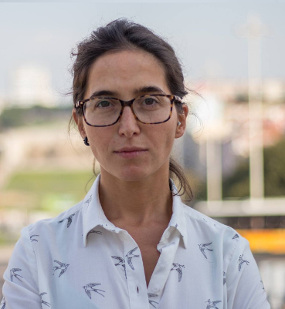Patrizia Paradiso
 Doctor of Material Engineering, with the dissertation “Strategies to improve the drug release performance of hydrogels for therapeutic soft contact lenses”, Instituto Superior Técnico, Lisbon, Portugal, 2015 (Fundação para a Ciência e a Tecnologia grant)
Double Master Degree in Material Engineering, Instituto Superior Técnico, Lisbon, Portugal, 2009 and Politecnico di Milano, Milan, Italy, 2010
Telephone: 21 8417146, Ext: 1146
Room: 0.10 (Mechanical II, bldg)
Email-adress: patrizia.paradiso@tecnico.ulisboa.pt
Google Scholar
Doctor of Material Engineering, with the dissertation “Strategies to improve the drug release performance of hydrogels for therapeutic soft contact lenses”, Instituto Superior Técnico, Lisbon, Portugal, 2015 (Fundação para a Ciência e a Tecnologia grant)
Double Master Degree in Material Engineering, Instituto Superior Técnico, Lisbon, Portugal, 2009 and Politecnico di Milano, Milan, Italy, 2010
Telephone: 21 8417146, Ext: 1146
Room: 0.10 (Mechanical II, bldg)
Email-adress: patrizia.paradiso@tecnico.ulisboa.pt
Google Scholar
Scientific affiliation
Member of the Departamento de Engenharia Mecânica, Instituto Superior Técnico – Universidade Técnica de Lisboa as researcher
Scientific fields
The areas of scientific interest are currently centred on the study and characterization of cementitious hidraulic binders.
Current research topics
- Study and modelling of cementitious hidraulic binders;
- Material characterization at the nano and micro-scale.
Former research topics include
- Controlled drug release;
- Hydrogels for ophthalmic applications;
- Biomaterials characterization;
- Production of drug loaded nanoparticles;
- Microfluidic devices for release tests;
- Quartz crystal microbalance with dissipation.
- Characterization of friction forces through AFM;
- Nanoparticles manipulation through AFM;
Scientific publications in international journals
- Paradiso, RL Santos, RB Horta, JNC Lopes, PJ Ferreira R. Colaço; Formation of a noncrystalline tobermorite in calcium silicate binders with low C/S ratio; Acta Materialia; 152:7-15 (2018) link
- P. Paradiso, R. Colaço, J L G Mata, R. Krastev, B. Saramago, A.P. Serro; Drug release from liposome coated hydrogels for soft contact lenses: the blinking and temperature effect; Journal of Biomedical Materials Research B Applied Biomaterials; 105 (7):1799-1807, October 2017. link
- P. Paradiso, A.P. Serro, B. Saramago, R. Colaço, A. Chauhan; Controlled release of antibiotics from vitamin E loaded silicone hydrogel contact lenses; Journal of Pharmaceutical Sciences; 105 (3), 1164–1172, March 2016. link
- F. Carvalho, P. Paradiso; B.Saramago; A M Ferraria; A M B Rego; P CB Fernandes; An integrated approach for the detailed characterization of an immobilized enzyme, Journal of Molecular Catalysis B: (2016);125: 64–74 link
- P. Paradiso, R. Galante, L. Santos, A. P. Alves de Matos, R. Colaço A. P. Serro, B. Saramago; Comparison of two hydrogel formulations for drug release in ophthalmic lenses, Journal of Biomedical Materials Research: Part B - Applied Biomaterials. (2014); 102 (6): 1170–1180. link
- P. Paradiso, V Chu, L Santos, AP Serro, R Colaço, B Saramago; Effect of plasma treatment on the performance of two drug-loaded hydrogel formulations for therapeutic contact lenses, Journal of Biomedical Materials Research: Part B Applied Biomaterials. 2015 Jul;103(5):1059-68. Epub 2014 Sep 19. link
- P. Paradiso, M.A. Rodrigues, R. Colaço, B. Saramago and A.P. Serro. Production and characterization of hypromellose phthalate nanoparticles containing levofloxacin for ophthalmic applications. Microscopy and Microanalysis, (2013) 19 (Suppl. 4), pp 151-152. link
- R Galante, P. Paradiso, M G Moutinho, A.I. Fernandes, J L G Mata, A P A Matos, R Colaço, B Saramago, A.P. Serro, About the effect of eye blinking on drug release from pHEMA-based hydrogels: an in vitro study; Journal of Biomaterials Science Polymer Edition 01/2015; 26(4):1-17. link
- F. Carvalho, P. Paradiso, P. Fernandes; A microscopic perspective of a microreactor, Microscopy and Microanalysis (2013); 19: 33-34. link
- A.P. Serro, R. Galante, A. Kozica, P. Paradiso, A. Gonçalves da Silva, KLuzyanin, A. Fernandes, B. Saramago; Effect of tetracaine on DMPC and DMPC+Cholesterol biomembrane models: liposomes and monolayers, Colloids and Surfaces B: Biointerfaces (2013); 116: 63-71.link
- J. G. Paiva, P. Paradiso, A. P. Serro, A. Fernandes, B. Saramago; Interaction of local and general anaesthetics with liposomal membrane models: a QCM-D and DSC study, Colloids and surfaces B: Biointerfaces, (2012), 95:65-74.link
|
 Doctor of Material Engineering, with the dissertation “Strategies to improve the drug release performance of hydrogels for therapeutic soft contact lenses”, Instituto Superior Técnico, Lisbon, Portugal, 2015 (Fundação para a Ciência e a Tecnologia grant)
Double Master Degree in Material Engineering, Instituto Superior Técnico, Lisbon, Portugal, 2009 and Politecnico di Milano, Milan, Italy, 2010
Telephone: 21 8417146, Ext: 1146
Room: 0.10 (Mechanical II, bldg)
Email-adress: patrizia.paradiso@tecnico.ulisboa.pt
Google Scholar
Doctor of Material Engineering, with the dissertation “Strategies to improve the drug release performance of hydrogels for therapeutic soft contact lenses”, Instituto Superior Técnico, Lisbon, Portugal, 2015 (Fundação para a Ciência e a Tecnologia grant)
Double Master Degree in Material Engineering, Instituto Superior Técnico, Lisbon, Portugal, 2009 and Politecnico di Milano, Milan, Italy, 2010
Telephone: 21 8417146, Ext: 1146
Room: 0.10 (Mechanical II, bldg)
Email-adress: patrizia.paradiso@tecnico.ulisboa.pt
Google Scholar

